Former India bowling coach Bharat Arun looks back fondly at his tenure with the Team India. (File)
Thank you for reading this post, don't forget to subscribe!Shared News: November 24, 2021 2:15:49 pm
India’s successful run India under coach Ravi Shastri and captain Virat Kohli, especially in Test matches, wouldn’t have been possible without Bharat Arun, who made the Indian bowling something to be feared and envied. Sriram Veera talks to the former India bowling coach, who looks back fondly at his tenure.
India’s successful run India under coach Ravi Shastri and captain Virat Kohli, especially in Test matches, wouldn’t have been possible without Bharat Arun, who made the Indian bowling something to be feared and envied. Sriram Veera talks to the former India bowling coach, who looks back fondly at his tenure.
***
What was the message you got when you re-joined the team in 2017?
I remember when I came on board in 2017, Virat Kohli and Ravi Shastri said we need to create a Test force. To do so, what do we have to do? Take 20 wickets, play five bowlers in any conditions. I had already observed the bowlers in my first short stint in 2014, and knew what was needed. We lacked the consistency required at that level to become a Test force all over the world. Kohli and Shastri were clear that rather than the extra batsman, we shall go with the extra bowler. I remember Kohli saying, “let us, the batsmen, take the load a bit. We are all good, surely the six of us are enough to do the job and we can unleash the bowlers”. At the highest level, you create pressure either by taking wickets or stemming the run-flow and squeezing them. To do that, consistency was key. The journey began in the nets. We had exceptional fast bowlers and spinners.
What was your coaching and bowling philosophy?
My main aim was to get the bowlers out of their comfort zone and try out stuff. It was about empowerment. Every bowler needs to be aware about what he is doing; why is the ball behaving in a certain way after it shoots out from his hand? What’s happening? How can he tame it and control it? How can he make it a deliberate act, rather than a vague ‘natural’ way? The strengths and the weaknesses, so that you stick to your strengths in the match and work on the weaknesses off it. The challenge is to understand everyone’s unique style and blend it as close to the basics of bowling, which frankly hasn’t changed in 150 years. Build a few variations to work around their main stock weapon. So that they can build a spell. How to work batsmen through a spell. Learn the art of constructing a spell.
You don’t coach the sport. You coach the person. It’s not about reinventing the game or talking too much technique, it’s in the background. You build a rapport, mutual trust, you playfully challenge them or be strict at times. Ultimately, it’s about ‘I am your big brother, I will support you and be with you all the time, but I will challenge you. I might irritate you but it’s for your own good.’
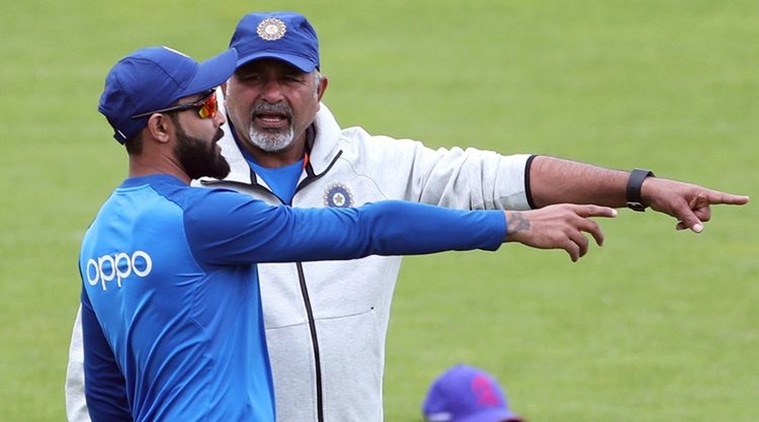
Bharat Arun during a net session. (FILE)
Let’s go one by one just to get an idea what kind of work was needed. Let’s start with Mohammed Shami, who had the goods but under you the transformation was immense.
With Shami, there were two faces: Shami, the bowler and Shami, the man.
He is a rhythm bowler and it was clear that his entire bowling depends on the kind of run-up he generates. It wasn’t about just running in fast. You run in fast enough so that you are absolutely balanced at the moment of delivery at the crease. For him, that was the key. When he was imbalanced, the transfer of force into the momentum of the delivery was lost. What’s the point in running fast and being imbalanced; the energy transfer goes down the drain. It was finding what’s the optimal speed of running to create momentum, but to help Shami hold balance. We explained the importance of this to Shami. Sometimes, too long a stride also affects the bowling. Sometimes he could do that. No point in being very stable also if you are not able to generate force. So, we tried it out to find his optimal. No point in talking too much technique to him, ‘let’s do it and give feedback about what you feel’. Trial and error works.
This can’t happen if he doesn’t trust and is willing to do hard work. He was. There were people who had told him – ‘don’t change anything, work with what got you here’ – which is sound advice, of course, but where is the growth unless you try, especially when one isn’t talking about big changes? He was ready as he learned to trust.
Talking of Shami the man, when he was going through his personal crisis, you and Shastri played a big role in pulling him out. What went down?
Shami was totally disillusioned. He was on the verge of giving up the game. When Ravi and I sat down with him, he said he was “extremely angry with life” and “I want to give it up”. We said, ‘it’s good that you are angry. You should be. Angry is best thing that has happened to you.’ He looked at us quizzically – what are these guys saying?! We told him, ‘You are a fast bowler; anger isn’t bad! Let’s get the bitterness out of it. Life has turned you into a very angry man, but what are you going to do now? You can quit, that’s your choice but you can also tell yourself that I am angry, how do I channelise it?’ We told him, “Tu shareer pay dhyan de. (Focus on your body, fitness). Go for one month to NCA (National Cricket Academy) and beat your body into shape. Take out the anger there. No arguments there, you do whatever is told to you.” He went and worked like a manic bull, I hear, and I remember him telling me, “mere itna taaqat badh gaya ki (I have gained so much strength) I can take on the world!” He was a strong guy and that anger phase actually helped him turn into something better. Whatever anger he had, he transformed into his bowling. You don’t have to be bull- headed aggressive, but controlled aggression is the key. His personality anyway doesn’t make him too aggressive; so a bit of anger was good as it pumped him up. No more laxity, no more ‘daalke dekhten hai, kya hota hai (let’s bowl and see what happens). He was now focused and ready each time at the top of his run-up. He was a true fast bowler now.
Shami’s wrist position and release is impeccable. He has one of the best seam positions in the world. With such a great natural release position where the seam is upright through the air, he gets more movement off the wicket than in the air which makes him dangerous. The batsmen have less time and they don’t know which way it’s going to move. He understood the importance of run-up and balance in his wrist position.
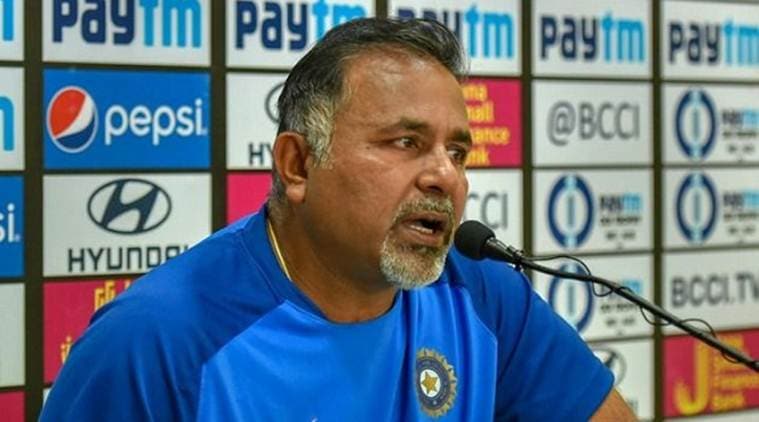
Bharat Arun is credited for Indian fast bowlers’ success in recent years. (FILE)
Ishant Sharma now; it wasn’t entirely clear at that point whether he would have the second innings in his career or fade away.
Ishant wasn’t making the batsmen play as much as possible. He had the consistency but we now wanted him to attack more, rather than dry up runs. As it was with most, it was just a small tweak. The angle at which he approached the stumps. It primarily came from the way he held the ball. If you see, the way his fingers sit on the ball is different from most seamers. He had it at an angle, slanted, dictated by his wrist position. That would make him push the ball away (from the right- hander) before his natural in-dippers would get the ball in. But he would end up pushing it a bit too outside off- stump. He was releasing from close to the stumps which is a good thing to do in general but with his set-up, it was going too far out and without coming back in as much as it used to do in his younger days.
So, we made him deliver from the centre of the box which gave him a better angle for his in-dippers, which made the batsmen play him a lot more. We also used his natural delivery to improve his round-the-stumps attack to left-handers. Now, the ball would be pushed in before leaving the lefties, which was obviously great. He became our banker bowler.
By then, since he had already played for so many years, it took a bit of convincing him to tweak the line of approach. I would tell him, ‘Let’s try this for a couple of days at the nets first. If you are not convinced, you can go back to what you were doing.’ That he said was fair enough. It wasn’t about changing his action but just the angle and little tweaks. It’s not that you don’t go close to the stumps at all. With his stock delivery, I felt it should be from the centre of the box. He was happy after a few sessions. When the angle at the crease changes, the wrist position changes automatically – just a bit, but enough for him. He could now make the batsmen play. That helps the inswing from a line that is more troubling for batsmen.
For not just Ishant, but for any bowler, the way you run and the way you load is the key. The rest is reaction. I work on that.
What was your equation with Jasprit Bumrah?
Bumrah wanted to excel in Test cricket: that was his dream. It’s fabulous to see how that desire drove him to excellence. The unorthodoxy in run-up and action helped him. He wanted to go beyond it. Boom was always willing to try out different things in nets. My job was to give the right feedback on what he is doing and why things are happening. He is extremely intelligent and a very quick learner. He naturally wanted to know why certain things are happening with the ball – my job was to empower that knowledge, that awareness. He learnt how to adjust to different lengths on different pitches. He would try a few different balls and observe what happens – the bounce, the movement, where it’s skidding from. He would tweak accordingly. We would talk during sessions, breaks, and I knew with him that it wouldn’t be overburdening him at all. He is someone who likes to have that knowledge.
When do you switch off as a bowling coach with all this constant chatter and thinking?
(Laughs) There is no switch off – it’s switch up and switch down. Occasionally, I would even get cricketing dreams! Especially in a Test match. With ODIs or T20s, the work sort of ends with that game. With Tests, it’s different. The thinking never stops. Are we bowling the right line, length? What should I tell the bowlers? Too much information in a game is also bad; what one little specific thing I can tell them tomorrow morning? It keeps going on. I love this job!
Bhuvneshwar Kumar is slowly playing just white-ball cricket. Should we resign ourselves to that?
He is outstandingly talented; how many bowlers can move the ball both ways as naturally as him? Every time he was bowling 135+, he looked very potent. He could have used far more of his talent and got far more Test wickets. Somehow that didn’t happen. The secret to him doing well is the kind of fitness he has. When the speeds have dropped, he hasn’t been as effective. It’s purely about his fitness and stamina.
Would you say Kuldeep Yadav has been one disappointment in your tenure?
Disappointment? Certainly not. His peak hasn’t come in my tenure, yes, but the kind of work we have put and importantly he is putting, means he is on the right path. He is young, and the future is still out there. He will be a force to reckon with.
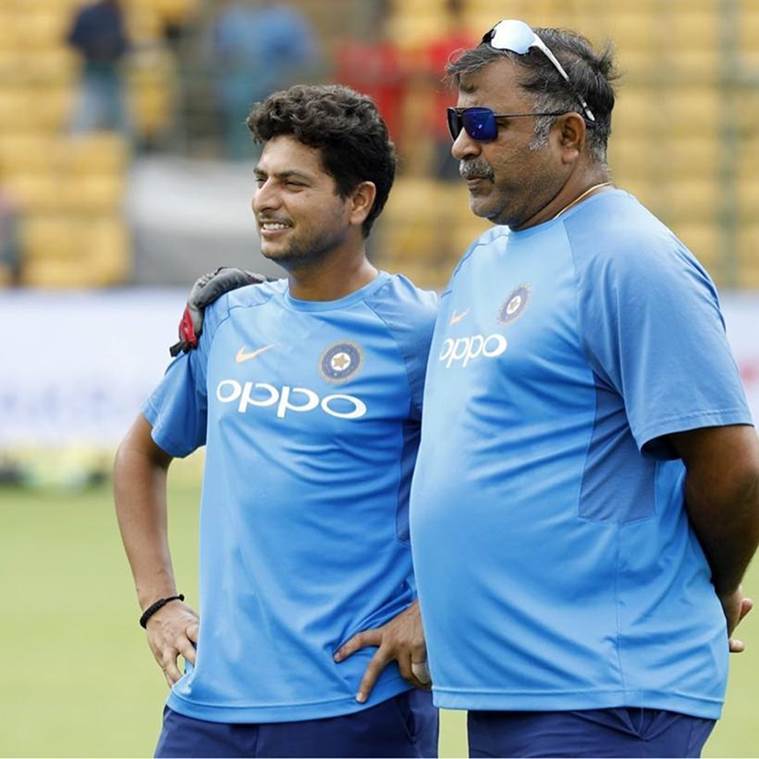
Bharat Arun with Kuldeep Yadav. (FILE)
All I want from him is to get more vigour through the crease. Getting that vigour is a combination of working more on the bowling and getting fitter. Vigour doesn’t mean firing it quicker. It’s not just about the speed. Once you get that vigour through the crease, the body comes fully into the action, you get more fizz. Yuzvendra Chahal does it when he is at his best. All components of the body involved in the action work together – more ripping turn, more fizz, more loop. Remember the ball he (Kuldeep) bowled in the 2019 World Cup to dismiss Babar Azam? It had everything. Kuldeep knows what he can do and I believe he can make a strong comeback. A spinner really matures when he is 27-28 and if he maintains fitness after that, he has 10 years of career. I think Kuldeep will get there.
R Ashwin is someone you have enjoyed working with, haven’t you?
Oh yes. A total delight. I thoroughly enjoyed my conversations with Ashwin. He would ask you lots of questions and to answer it convincingly – he is an extremely intelligent guy – I had to dig deep into my knowledge. It was a very enriching experience to learn nuances of spin from him. I see a part of coaching is about learning from the bowlers also. Like the knuckle ball from Bhuvneshwar Kumar. To understand how they do it, so that I can then teach another fellow its nuances.
The best thing about Ashwin is, no matter what he has achieved, he isn’t afraid to come out of his comfort zone at all. It’s a natural part of his personality.
Technically, we have seen him with different load-ups according to what he wants: overspin or side spin. How does it all work?
In Australia this time, he loaded up in front of the face, almost. It helped him stay upright and generate more overspin. He would do little things: lean forward at release, weight on front, when he wants to bowl slower without making it obvious with his arm-speed. He would arch back after loading when he wants more dip and turn. My job would be to observe these little things, see if something is going wrong, and point out if necessary.
Occasionally, little errors would creep into his bowling. I remember once in 2014, the alignment went a bit wrong. The front leg was going too far across in the delivery stride, a matter of inches. It comes from the body positioning, the alignment from the back foot impact to the front. It’s a dominos effect. The first thing goes wrong, then the subsequent ones tend to go out of shape. Just as batsmen talk about being in shape, bowlers need that as it affects the balance. With Ashwin, the body position had changed a bit, and we realigned it. Then things fell into place.
The “betrayal of body”, as he called it, hampered him in 2018. What was happening?
In 2018, near the end and after that tour of England, Ashwin was quite disillusioned. His body, fitness prevented him from achieving what he could. Remember, he had started beautifully in the first Test at Birmingham. Then his body came in the way. I could understand his frustration. The injuries that didn’t help him finish his action.
Maybe, what happened to him then was a blessing in disguise as right now he has taken care of his diet, his exercise regimen and is the fittest he has ever been. The knowledge and experience that he has acquired is all kicking in beautifully. Not a surprise then that he has forced his way back into white-ball cricket also. I would go as far as saying you would see the best period of Ashwin in the future. Everything is syncing really nicely.
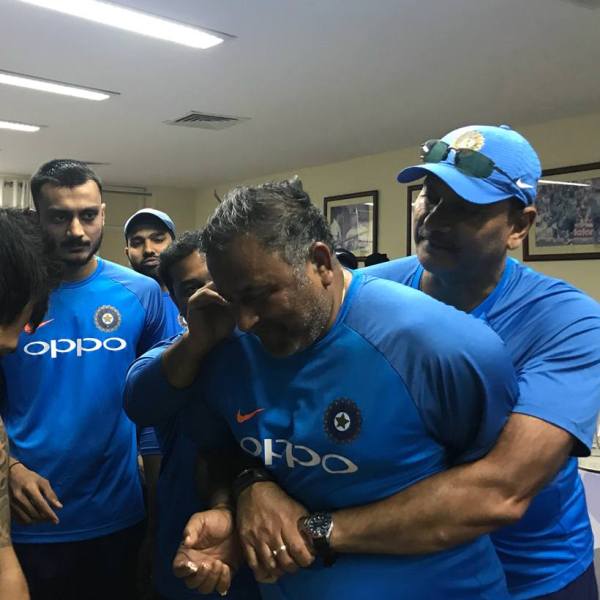
Bharat Arun with head coach Ravi Shastri and team members during his birthday celebration. (FILE)
What about Ravindra Jadeja?
Jadeja is a boon to India. Since 2018 tour of England, he has matured beautifully as a batsman. His bowling has a lovely rhythm, a banker bowler now, and if there is a little help in the wicket, he is very dangerous. And we all know what energy he brings on to the field. A beautiful package, on the whole. Spin is fine, with Axar Patel also coming along nicely and as I said, Kuldeep will come back.
In the little opportunity he got, Shardul Thakur is coming along superbly. Just imagine the pressure and how well he has coped and grabbed them. Each match, I see tremendous improvement – bowling and batting. Knocks in Brisbane and Oval were amazing, no? And he is a pretty intelligent bowler – a lovely outswinger at close to 140 kmph and a well-directed bouncer. He is a good thinker, not afraid to speak his mind, fearless, and you need players like him in a team environment.
Let’s move on to the larger strategies your team employed. Like that middle-stump, occasionally even middle-and-leg in Australia.
Ravi Shastri’s idea. For the likes of Steve Smith and Marnus Labuchagne’s ability to score on the off-side. I remember Shastri said, “Let’s take the off-side out of the equation!”. I thought about it, discussed and debated with him first. Months before the tour. We decided we would strengthen the legside and bowl more on the stumps line. We will try and dry up the runs as 75 per cent of their runs were coming on the offside.
The captain had to buy into that plan first. Kohli heard us out patiently, thought about it and was hooked. Once he did that, the bowlers also did as it actually suited most of our bowlers. Except probably Shardul Thakur, as he has a natural outswinger. He struck to his strengths in Brisbane and got four wickets. Most of the others, it suited them to bowl the stumps line and bring the ball back in. Luckily for us, the first few times we tried, it worked and it started to prey on them (Australians).
Injuries hurt us but even the new ones who came in, that plan worked. Someone line Mohammed Siraj was now clear about what to bowl when he was at the top of his run-up. It was simple, now.
Siraj is someone you worked with in Hyderabad before his international debut. A word on him, please.
I was extremely happy to see him do well as I knew the kind of hunger he had when playing for Hyderabad. He would call me every time he did well – this was after I had moved to the Indian team – and say “sir, mujhe kab bula rahe ho aap Indian team mey?! (When are you calling me to the Indian team?!) I would say, “keep performing, I don’t have to call in, you can walk in.” He will say “That’s alright, but you also keep me in mind!” Every time he performed, I knew a call was coming. “Sir, now India A mey I performed, or whatever the case may be. When are you calling me into the team?” His passion is quite something.
The biggest asset is line and length. You tell him the plan, give him the length to bowl on a particular pitch and the line and you can rest assured that he will do it ball after ball. He looked as if he belonged there even in his first Test. Good enough to win matches.
Umesh Yadav hasn’t got that many opportunities.
Yes, he has had that bad luck but it doesn’t take away from the bowler he is. He is also someone who has consistently improved. The balance at the crease has improved, the radar is in his control now. He can reverse the ball at pace, he can get the ball to skid, and considering the number of options we have had, he has been used more in Indian conditions. That’s just a call about the kind of bowling attack needed in different conditions. It’s a testament to the Indian line-up that someone like him hasn’t always played.
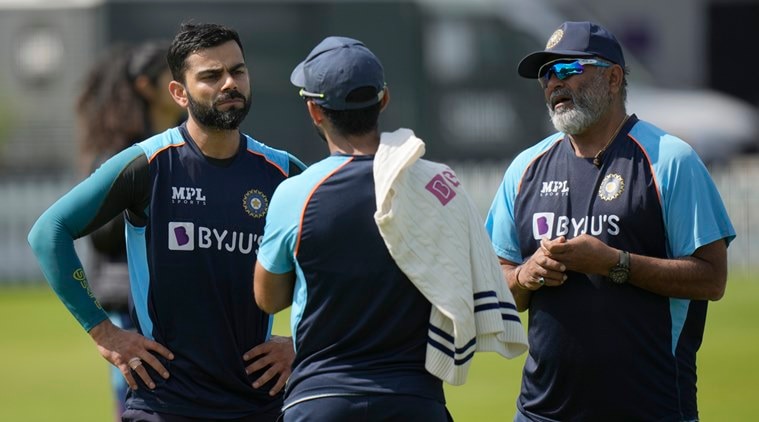
Virat Kohli and Bharat Arun talk during a practice session on Aug. 10, 2021. (AP Photo/Alastair Grant)
You weren’t just a bowling coach, but along with Shastri, you played a larger role. Let’s talk about the post-36 all out in Adelaide.
It was easy to help Shastri. We have a relationship for years and we shared the same committed dedication. I would be his sounding board, he would be mine and the way he would communicate to the team: straight, simple, inspiring, very effective. He knew the importance of temperament and attitude. I remember he said after that Adelaide loss: “What now? Are we going to shy away and fold? The Australians would expect us to be gone, expect us to crumble and surrender. One game’s loss is just that: one loss. Momentum is what we make of it. Let’s wear this 36 all out as a badge and go out there. This is an opportunity to come back from the dead.” Just not Shastri or me, but I would say the entire support staff was instrumental in lifting the morale of the team. To make them think they can come back. Because in our minds, it was simple: we aren’t such a bad team to be getting out for 36. The players responded magnificently. They wanted to prove to the world that they are much better than this. It was a question of ability and will. Shastri ensured that they knew that they had the ability and it was now a matter of the will and the players said they have the will too. Job done.
All this in the background of, mind you, relaxing. We didn’t panic immediately. I remember playing dumb charades and stuff like that. No harsh words from anyone. As Shastri would say often, “it’s not what you accomplish but it’s what you overcome”. The players bought into that philosophy.
That Sydney Test draw. What was going on in your mind in the dressing room? Shastri had sent a message to Rishabh Pant but then he got out. From a peek at a win, now things had changed.
Rishabh was playing beautifully and Shastri had told him how to deal with the spread-out fields. But in the rush of the moment, he got out trying to hit Nathan Lyon over the top. Rishabh would learn from it and use it brilliantly in the next Test at Brisbane. I remember Ashwin couldn’t sit at all in Sydney because of his back pain. For two-and-a-half-hours, he stood, saying that “I can’t sit down”. To play that knock after that was so special. So was Hanuma Vihari, who too had an injury, but fought so bravely. When they came in at tea, they said, “we won’t give up. We will save this game.” That was the confidence level they had.
That final day in Brisbane, when everyone would have been happy with a draw, the players went for the win. What was running through your mind?
All the support staff were sitting and wondering ‘what to do?’. We decided that the boys have shown tremendous mettle so far and if they feel that they can cross the line, let’s just sit back and enjoy the game. No instructions were given. They did it on their own – and that was a great thing to happen. In the past, Shastri has talked about how it was okay to lose in going for a win and we were watching the boys do that. We just looked at each other and said, ‘let’s just enjoy this. It’s going to be a real special day’.
Like the Australian tour’s line of attack, what other action plans give you satisfaction as a bowling coach?
Even in the previous tour of Australia where we won, we bowled a lot fuller than what Australians did to us. There was some help from the wicket and our bowlers are good at moving the ball. To do it, we had to get it fuller. Even on the recent tour of England, our bowlers moved the ball at Lord’s, and at Leeds when even the English bowlers didn’t get much movement, our bowlers did. It’s about empowerment and bowlers by now understood what was needed.
In South Africa, during the Johannesburg Test, the lengths of the two teams were different. Because of movement on offer, South Africans bowled a tad shorter. But we still went further up and it was rewarded.
You watched the Shastri-Kohli partnership from close quarters. Much has been said about them. How did you see Kohli?
Virat Kohli is the best thing to have happened to Test cricket. The Indian team, what it is today as a Test- playing nation, a lot of credit must go to Kohli and Shastri. No two ways about it. This didn’t happen overnight. I have seen and been part of countless chats between them where they would plan how to become Test No. 1. How to actively get the team into thinking that there was no need to be shy or defensive about having that goal. To win overseas. To be a dominating force. Virat’s passion was Test cricket and so was Ravi’s, and they wanted to make this team good everywhere and across all formats. I am not saying we achieved all our goals but we have left the team at a much better place than where it was. To be a no. 1 team in the world for five years in a row is some achievement.
Virat was a very aggressive captain and just like any other batting or bowling ability, his captaincy also improved every year from the confidence of doing well. We have made mistakes, learnt from them, and over the years, his captaincy has really improved. The aggression, energy and the ambition to be the best team in the world was a wonderful combination. If he didn’t have that thought, that desire to excel, we wouldn’t have been where we are today.
Virat was never afraid about the five-bowlers theory. Let the batsmen take onus. We have to do it. He was clear that whatever we do, we need to take 20 wickets. Four bowlers would have done it in a few Tests but to sustain it would have been difficult. Kohli also would be there to discuss the bowling plans together with the bowlers. The captain, bowlers, head coach and me – all of us need to be on the same page.
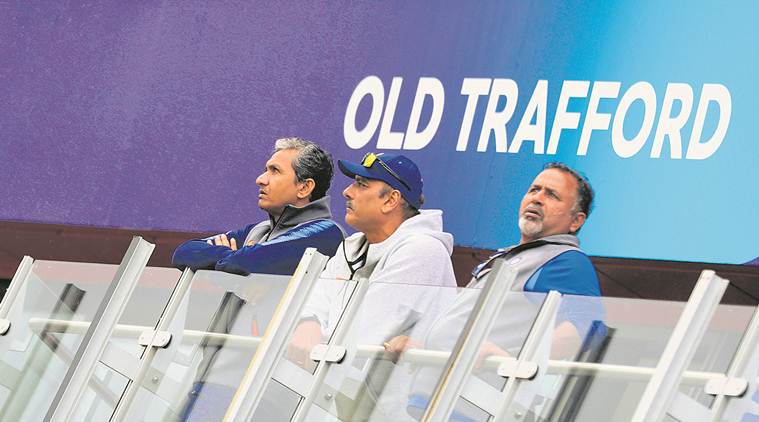
Ravi Shastri, support staff Bharat Arun and Sanjay Bangar were given automatic entry into the recruitment process. (AP)
Word on what values Shastri brought to the table?
Fearlessness and honesty. During his tenure, there was absolutely no agenda. The decisions might have been right or wrong, that is irrelevant, but they came from the right place, purely thinking about team values and what we stood for as a team. Honesty encompasses criticism, self-introspection. It was in telling the team that ‘accept that we messed up’. It helped us evolve the team.
There were a couple of potentially delicate moments in the tenure. When Kohli became captain, Dhoni was still around. What did Shastri tell Kohli?
Ravi told the importance of having a senior member like Dhoni in the team. It was about giving a lot of respect and he would definitely help him. Kohli understood that of course and it was a seamless transition. You could see the respect in the way Kohli would often let Dhoni handle little details and prowl on the boundary in ODIs. That kind of stuff can’t have happened without trust and respect. And Dhoni also saw he was given the space and responded so well.
The second was recently with the rise in Rohit Sharma’s stocks. How did that play out?
There was a storm that was built up from outside the team. These two have a lot of healthy respect for each other and there has been a constant dialogue going on. For us to do well, a team needs to be in good harmony to achieve. And it was.
Who are the new bowlers that we can look forward to coming through?
Prasidh Krishna looks good. Avesh Khan looks a very good prospect. And Umran Malik is upcoming, young and raw but looks impressive. We have Thakur and Siraj, still young and new only, don’t forget.
In spin, I haven’t seen many new faces burst through like it has been in pace but Ashwin, Jadeja, Axar and Kuldeep will come back.
And, what’s your take on Rahul Dravid? And the new bowling coach Paras Mhambrey?
Dravid has been fabulous and is the right man to take over from Shastri. And Paras is good and has a great working relationship with Dravid. I am sure they will do a great job. I would always be available in case he wants to pick my mind on something.
Finally, players take stumps, balls, and stuff as memorabilia. What souvenirs do you have from this tenure?
Autographed shirts. As a bowling coach, I should have pulled my weight and grabbed a few balls! (Laughs) But I didn’t. Shirts and happy memories of all the bowlers and players doing so well. What more can I ask?



